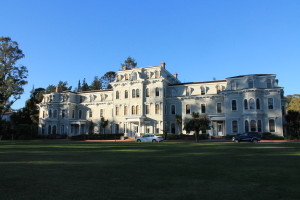On the nights after Donald Trump was elected president, thousands of people, including many Mills students, took to the streets in downtown Oakland to protest.
Oakland was not alone in fighting with public demonstrations on Nov.10. After Donald Trump’s contentious win, protests erupted in cities across the country, signaling a nation-wide backlash against the controversial businessman.
An email from ASMC president Erin Clark was sent in the afternoon to provide resources for students to remain safe and organized. In addition, Clark attached a Google spreadsheet, providing protest contact information for students and faculty to contact others in case of an emergency.

Mills sophomore Maia Ziaee claimed to have seen about 30 other Mills students at the protest that night, giving her a sense of solidarity.
“It was really unifying to see other Mills students,” Ziaee said.
People gathered at Oscar Grant Plaza on the night of the election and the nights following to protest. Activists who organized the event, the Black Power Network and the Anti-Police Terror Project, spoke on the implications of Donald Trump’s presidency and what it means for action in the future.
“Donald Trump is one person; it is a systematic problem,” said a speaker from the Anti-Police Terror Project.
Signs read “F**k the electoral college” and “Not My President,” showing the protester’s discontent with Hillary taking the popular vote and Trump winning the Electoral College, thus winning the presidency.
While the crowd was heating up, police began to concentrate at the corners around the gathering, armed in riot gear that included visible zip-ties, an indication that they were ready to arrest.
On the first day of protests on Nov. 9, following the results, the crowd marched down Broadway and Webster, encapsulating several blocks at a time. The speaker would alternate between speaking, leading chants and playing music like Kendrick Lamar’s “Alright” and YG’s “FDT,” to unite the crowd.
According to multiple students at the protests, the police deployed tear gas at the end of the protests on both Wednesday and Thursday night.
“After the tear gas went off, we saw one guy blinded by it,” Mills junior, Irena Huang said. “The crowd was yelling ‘Help him‘.”
After the first protest had officially ended, people took to the streets smashing windows, tagging buildings, and burning flags, causing mixed opinions about the degree that protesting is effective.

“Lots of people are saying it’s ineffective and creates a bad image for protestors,” Mills sophomore Opal Wilburn said. “But on the other hand, bad images are not really the concern that we are trying to address right now because the bad image that I would consider more important is Donald Trump as president.”
One student, who wished to remain anonymous, does not agree with using protest as a method for political action. They prefer to fight through law and legislation.
Ziaee was upset by the way the mainstream media covered the event afterwards, focusing on the vandalism and fires.
“What bothered me about it was just the portrayal of it by the media after the fact,” Ziaee said. “I was bothered by the way it was talked about afterwards, with words like ‘violent riots in Oakland,’ because that wasn’t what it was.”
As for the vandalism and fires, Huang does not think that sums up the point of the protest.
“Thousands of protesters marched peacefully for hours, it wasn’t until the end when things were being vandalized,” Huang said.
As for who was doing it, Huang does not think they were there to protest with the community.
“I didn’t see a single person of color tagging things, smashing buildings, or starting street fires,” Huang said.
Oaklandish was one of the stores vandalized, and they responded in a tweet Wednesday night, reading “Well. Thank you Oakland. Hopefully not Oaklanders.”
At time of press, Friday Nov. 11, the only coverage had been up to Thursday night. Stay tuned for more protest coverage from The Campanil.




